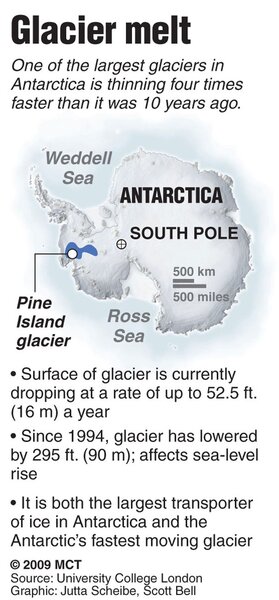Of farming, methane bubbles, and Antarctic glaciers
Loading...
Climate-related studies continued arriving apace this week.
Writing in the journal Geophysical Research Letters, scientists warn that the Pine Island Glacier in West Antarctica is shedding ice four times faster than a decade ago. Scientists have been tracking the glacier, roughly twice the size of Scotland, with satellites for the past 15 years.
At this rate, it will mostly disappear within a century — six times faster than previous estimates. [See Newscom graphic at right.) And if it melts, seas will rise nearly double what the Intergovernmental Panel on Climate Change predicted for this century. (Depending on different CO2 emission scenarios, the IPCC's estimates for sea level rise range between 7.2 and 23.6 inches by century's end.)
Earlier this year, NASA's Robert Bindschadler, another glacier expert, told Yale's environment360 magazine that the Pine Island Glacier now flowed into the sea at a rate of 1 foot per hour, 50 percent faster than five years ago.
In the interview, he explained why glaciers in West Antarctica are so sensitive to changes in climate:
The warm water has an easier time getting to the glacier from the middle layer of the Southern Ocean, which is where the heat is. So the continental shelf is just at the right depth to allow that warmer water a small upward nudge to get up onto the shelf and it gets directed right towards the glacier. We’re pretty sure that this is why this part of West Antarctica is acting in such a dramatic way. The glacier is thinning rapidly and accelerating five to ten percent per year.
Also in Geophysical Research Letters, scientists from the National Oceanography Centre in England report that a 1 degree C warming of the Arctic current over the past 30 years is probably melting methane ice in seabed sediments.
Using sonar, scientists have discovered over 250 plumes of methane bubbles rising from the seafloor west of Norway's Svalbard archipelago. A potent greenhouse gas, methane is over 20 times more powerful than CO2. This is the first time that methane bubbles in response to climate change have been observed in the modern period, say the authors.
In the ocean, methane hydrates form at a depth where the conditions are just right. Those conditions include sufficient water pressure from above and the cold temperatures of the deep ocean.
But that methane freezing zone seems to be retreating deeper, say the authors. Thirty years ago, methane hydrates were stable at depths greater than 360 meters. Now, it's necessary to descend beyond 400 meters to keep methane hydrates solid.
These observations are troublesome for a number of reasons. A warming ocean, scientists have long hypothesized, may cause methane hydrates to melt around the world. And a pulse of methane entering the atmosphere could, in turn, trigger more warming.
Indeed, scientists have also long surmised that just such a positive feedback led to dramatic warming episodes in Earth's past — such as, perhaps, the end-Permian extinction 251 million years ago, the largest of Earth's five mass extinctions, or the Paleocene-Eocene thermal maximum some 55 million years ago.
In this case, the (relatively) good news is: that the plumes of methane bubbles seem to be dissolving in the sea water before reaching the surface; they're not entering the atmosphere directly. The bad news: Methane contributes to ocean acidification, which, among other things, negatively impacts shell-forming creatures' ability to grow their shells.
Finally, a study reported in the journal Quaternary Science Reviews concludes that humans have been altering climate for as long as we've practiced slash-and-burn agriculture — that is, since agriculture was invented.
That's not a new hypothesis. William Ruddiman, one of the study's authors, first proposed the idea five years ago. By cutting and burning forests, humans have been altering climate throughout much of the Holocene, the past 10,000 years or so, he argues.
But when he first proposed it, some countered that, even if humans had been altering the landscape, our numbers were so small for so much of our history that our impact on climate was likely negligible.
But in this new study, Ruddiman says that, when it comes to agriculture's impact on climate, the current human per capita footprint is now far less than that of our slashing-and-burning forebears. People used to burn down forests or savannas, plant crops, and replant until the soil was exhausted. Then they'd clear a new patch and repeat.
The end result: People cleared five times the land they actually farmed at any given time, he says. Now, with modern agricultural techniques, we get about 90 percent more out of the same plot of land than the farmers of yore would have.
That's good news in one sense; it means we've greatly improved efficiency. But in another sense, it shifts more responsibility for climate change to our farming ancestors than we usually give them. They may deserve more credit for initiating the ongoing — and inadvertent — experiment in climate engineering we call "global warming" than they usually get.





